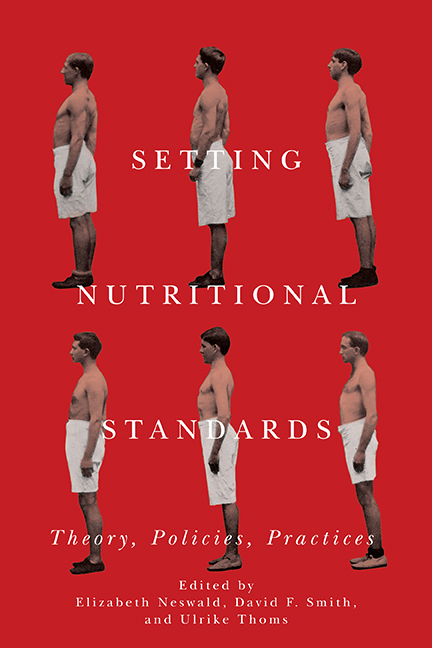Book contents
- Frontmatter
- Contents
- Acknowledgments
- Introduction
- 1 Nutritional Knowledge between the Lab and the Field: The Search for Dietary Norms in the Late Nineteenth and Early Twentieth Centuries
- 2 How Vegetarians, Naturopaths, Scientists, and Physicians Unmade the Protein Standard in Modern Germany
- 3 Of Carnivores and Conquerors: French Nutritional Debates in the Age of Empire, 1890–1914
- 4 Setting Standards: The Soldier's Food in Germany, 1850–1960
- 5 The Quest for a Nutritional El Dorado: Efforts to Demonstrate Dietary Impacts on Resistance to Infectious Disease in the 1920s and 1930s
- 6 “Not a Complete Food for Man”: The Controversy about White versus Wholemeal Bread in Interwar Britain
- 7 “Proscribing Deception”: The Gould Net Weight Amendment and the Origins of Mandatory Nutrition Labeling
- 8 When Is a Famine Not a Famine? Gauging Indian Hunger in Imperial and Cold War Contexts
- Selected Bibliography
- List of Contributors
- Index
7 - “Proscribing Deception”: The Gould Net Weight Amendment and the Origins of Mandatory Nutrition Labeling
Published online by Cambridge University Press: 18 April 2018
- Frontmatter
- Contents
- Acknowledgments
- Introduction
- 1 Nutritional Knowledge between the Lab and the Field: The Search for Dietary Norms in the Late Nineteenth and Early Twentieth Centuries
- 2 How Vegetarians, Naturopaths, Scientists, and Physicians Unmade the Protein Standard in Modern Germany
- 3 Of Carnivores and Conquerors: French Nutritional Debates in the Age of Empire, 1890–1914
- 4 Setting Standards: The Soldier's Food in Germany, 1850–1960
- 5 The Quest for a Nutritional El Dorado: Efforts to Demonstrate Dietary Impacts on Resistance to Infectious Disease in the 1920s and 1930s
- 6 “Not a Complete Food for Man”: The Controversy about White versus Wholemeal Bread in Interwar Britain
- 7 “Proscribing Deception”: The Gould Net Weight Amendment and the Origins of Mandatory Nutrition Labeling
- 8 When Is a Famine Not a Famine? Gauging Indian Hunger in Imperial and Cold War Contexts
- Selected Bibliography
- List of Contributors
- Index
Summary
As a vehicle for conveying nutritional information to the individual consumer, the modern US food-package label has evolved steadily throughout the twentieth century, and its content and format are regularly revised to reflect and apply new knowledge in the fields of medical, nutritional, and regulatory science. Today, the most prominent feature of that label is the Nutrition Facts panel, which has, since it first appeared in 1994, become the most widely recognized graphic in the world. Although the current food label focuses on nutrition and health, the roots of mandatory food labeling lay in the commercial landscape of the Progressive Era in American history.
In 1913 the first mandatory food labeling law was enacted—the Gould Net Weight Amendment to the 1906 Pure Food and Drugs Act—which required that all packaged foods have the “quantity of their contents plainly and conspicuously marked on the outside of the package in terms of weight, measure, or numerical count.” The United States thereby became the first country in the modern world to enact mandatory food labeling in lieu of voluntary compliance with published standards, and paved the way for the twentieth-century adoption of mandatory nutrition labeling.
In addition to its groundbreaking legal significance, the obscure Gould law is also historically important as a small yet compelling example of the critical role that standardization in many fields played in changing the commercial, social, and economic landscape of America during the Progressive Era (ca. 1890–1920).
In an era challenged by immigration, industrialization, and urbanization, the scope and scale of such change was unprecedented. Reforming activists drew support from a growing middle class, professionals began to transform many fields of endeavor, and in science and engineering, in particular, greater efficiency served as both goal and symbol of the Progressives’ commitment to the nation's overall advancement.
Over time, the Progressives profoundly influenced local, state, and federal government agencies, originally in an effort to curb political corruption, but increasingly as a means of promoting order and efficiency. One key to their success was their reliance on new scientific knowledge, methodology, and tools.
- Type
- Chapter
- Information
- Setting Nutritional StandardsTheory, Policies, Practices, pp. 165 - 194Publisher: Boydell & BrewerPrint publication year: 2017



